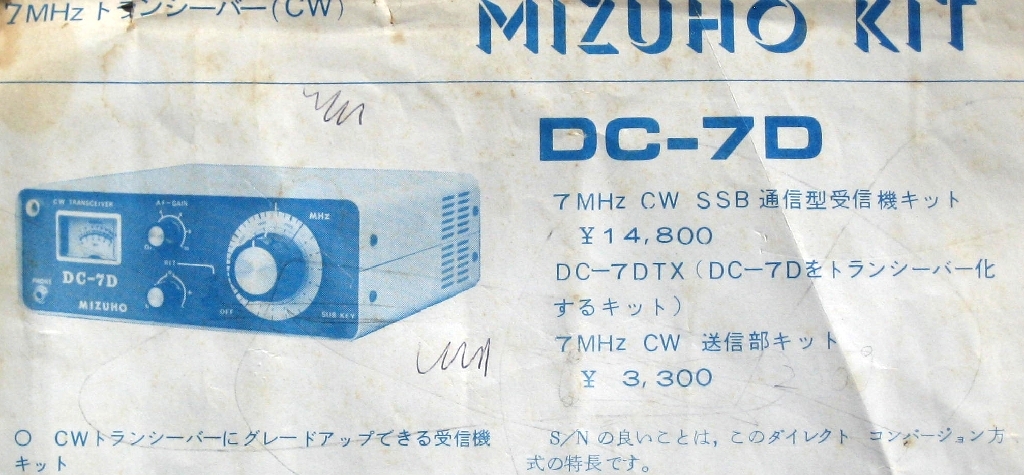JK1SXR
=>Japanese
Return to "A Home"
1. Antenna and
child view
2. IC-746 LCD
back-light repair
3. Oscilloscope and
stray magnetic flux
4. VX-5 main switch
restoration
5. Gagarin 55
6. DP vs discone
for air bands
7. First station
CW 1-watt
8. First station
Vertical ANT + DC-7D
9. First station
First QSO
10. PC renewal
Data transfer mystery
Return to "A Home"
1. Antenna and
child view
2. IC-746 LCD
back-light repair
3. Oscilloscope and
stray magnetic flux
4. VX-5 main switch
restoration
5. Gagarin 55
6. DP vs discone
for air bands
7. First station
CW 1-watt
8. First station
Vertical ANT + DC-7D
9. First station
First QSO
10. PC renewal
Data transfer mystery
C. SXR radio notes
9. First station / CW 1-watt application
I began the amateur radio station in 1978, already 40 years ago.
The rig I prepared for the operation is a DC-7D transceiver of Mizuho Communication.
Unfortunately the machine is no more at hand. The following shows a part of its catalogue.

Strictly speaking, the DC-7D is a receiver. This and the transmitter unit DC-7DTX constituted the transceiver of 1-watt output dedicated to 7 MHz CW. In retrospect, it was indeed a stalwart machine. This is an assembly kit including the already completed VFO unit, and the assembly itself was not so difficult.
As I had thought amateur radio suited CW best, and it looked awkward for me to talk something like "hello CQ" aloud (so even now), I decided to start the station with 7 MHz CW only. So I practiced to send Morse codes with a Hi-MOUND key.
As for CW reception, I had no problem as I had long heard of the kind of scheduled calls of such coast radios as Choshi, Nagasaki, S.F. / JCS, JOS, KPH.
Because the then test speed of "CW class" looked too slow, I skipped it and got the "Second class" license. The tests were easy, as the CW tests up to the second class was only for English Morse without the local codes.
Later I forcibly practiced the Japanese Morse and got the first class license. And I came to realize that there was no irrational and unreasonable thing in the world than this local Morse. Then soon afterward, the Japanese Morse test was abandoned, and I was really discouraged.
Immediately after getting the 2nd-class license, I applied the station certificate with the DC-7D only. Since there were already many SSB transcievers on the market, in retrospect, this type of application must have been exceptional and rare. Still the station license with a big seal of Kanto Radio Wave Administration Bureau Director was issued with no particular problem.
Seeing its copy now, the column for the "Radio wave type, frequency and antenna output", naturally enough, indicates only a single line.
A1 7050kHZ 10W
That is all.
Compared with the present certificate specifying those from all HF bands to VHF and UHF with more than 10 lines, this was really something courageous.
Though I think that the so-called QRP operation is for experienced operators and not anything to be recommended to beginneres, it is a good point of the amateru radio that we can start with this type of minimal installation.
Copyright © 2013 JK1SXR/abemasa. All Rights reserved.